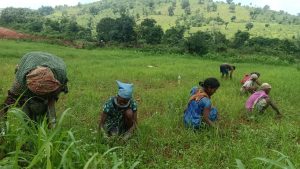Malkangiri: Bonda tribals, one of the most primitive tribal communities living in Malkangiri district, are facing an extinction threat due to high infant mortality rate (IMR) in their community. This has taken a toll on the Bonda population as it is shrinking alarmingly putting their identity at stake. Bondas are one of the 13 Particularly Vulnerable Tribal Groups (PVTGs) residing in Malkangiri district since ancient times.
However, their population is much less in comparison to other tribal communities of the state. The reasons are many, with high death rate among infants being the most concerning. Continuous efforts are being made to increase their population with the involvement of various voluntary outfits and government agencies but the members of this community are yet to reap the benefits of various welfare schemes.
It is alleged that tangible development still eludes the tribe, though the government claims that huge sums of money have been spent for the socio-economic uplift of the community. The state government is consistently working for the development of the community. However, such initiatives are yet to see progress in the region.
Bonda tribals reside in Mudulipada, Andrahal, and Badadurai panchayats under Khairaput block of the district which is at an altitude of 5,000 feet above sea level. Their population amounts to only 6,700 people living in 245 houses spread over 32 villages under the block. A Bonda woman gives birth to around five to six children during her lifetime.
However, they are not aware of the complicacies regarding child birth and upbringing. This is because Bonda society is mostly matriarchal as they are the primary workers and providers of food for their families. They leave their newborns unattended back home and go out to work to earn and collect food for the family.
Many also carry their babies with them to their workplace. As a result, they often fail to take care of the newborn or feed them properly which affects the children adversely. Moreover, the women become pregnant and give birth again within one or one and half years of their first delivery.
The absence of gap between childbirths adversely affects the children as they suffer from various illnesses which finally result in their deaths. This has led to high infant mortality eventually resulting in a decline in their population. The state government has over the years tried to bring the Bondas into mainstream and set up the Bonda Development Society (BDA) in 1996 with this aim.
To reverse the decline in population, there is an urgent need of availability of proper healthcare services and scope of education. The government has established schools in the Bonda hills to educate the community but many of them are not inclined to read and learn. Despite initiatives, only six per cent of the Bonda children have received education.
A primary health centre (PHC) has also been set up at Mudulipada to provide them healthcare services. It has also engaged ASHA and Anganwadi workers in various villages to take care of the pregnancy and delivery needs of Bonda women. Efforts have been made for the implementation of family planning programme among Bonda women but they are staying away from it due to lack of awareness.
Anganwadi and ASHA workers are regularly conducting health examinations and providing them with nutritious cooked food and sattu. They are also admitting the Bonda children to Anganwadi centres and providing them education. These efforts have resulted in some development but there is a need to sensitise them to fully assimilate them with the mainstream and revive their declining population.
.
From: orissapost
URL: https://www.orissapost.com/high-imr-threatens-bonda-population/
